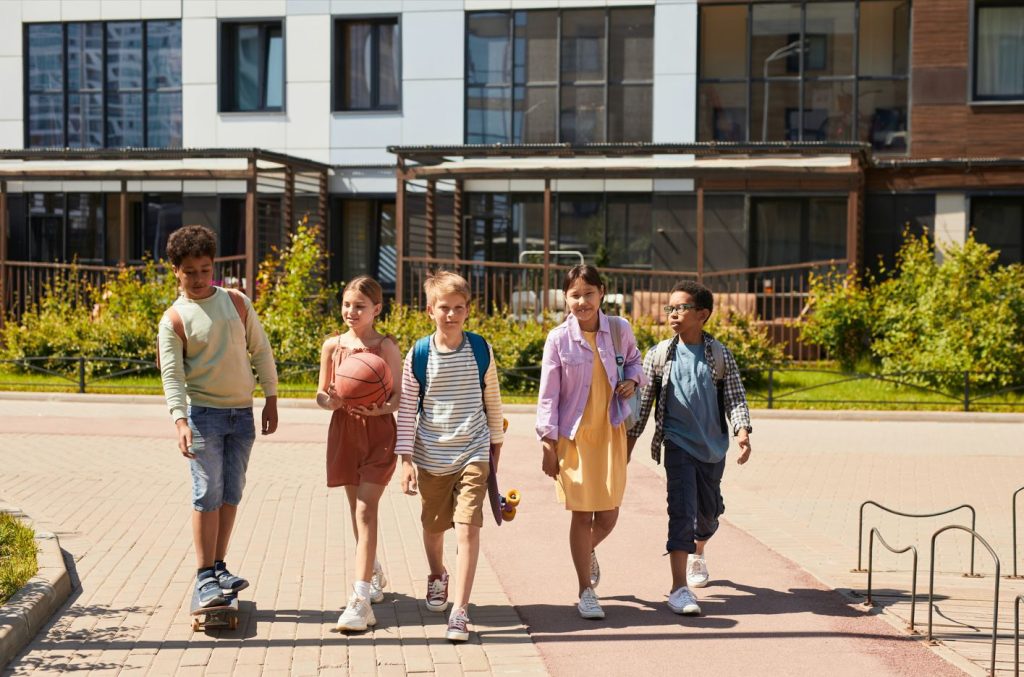School belonging
by Mathilde Bjørnset – OsloMet
Children spend more and more time in school. By the turn of the 20th century, many countries had made schooling compulsory, as mass schooling had accompanied the industrial revolution (Leonard, 2016). In Norway, there has been a drastic increase in yearly teaching hours from 6,904 in 1997 to 7,686 in 2022 (Moen, 2023). This is both due to the enrollment of six-year-olds in school in 1997, lowering the starting age by one year, and due to the average school day consisting of more teaching hours. This development has led to Norwegian children spending five times as much time in various educational institutions before they turn ten, compared to 40−50 years ago (Nordahl, 2012).

A feature of late modernity is its high degree of dynamism, characterized by rapid change, growth, and innovation brought about by cumulative social, technological, and cultural acceleration (Rosa et al., 2016). This ever-increasing production and consumption, demand an acceleration in knowledge. As a lack of education can bar someone from the labor market, schools have evolved from a selection system for some and a retention system for many to a selection system for all (Frønes, 2018). Never before have more individuals dedicated so much time, resources, and energy to becoming educated, as in this “schooled society” (Baker, 2014). The downfall of late modernity’s high pace is desynchronization, causing individual burnout.

The core goal of the education system is to prepare children for their future, as an investment in human capital. A sense of belonging in school has been found to have a positive impact on academic achievement (Hodges et al., 2018; Slaten et al., 2016), being an important predictor of future outcomes. When spending as much time during childhood in school, belonging also matters for how children are doing in the present, not only a matter for the future. When school belonging is found to be decreasing (Allen et al., 2018; Bakken, 2023; OECD, 2019), this should be of concern both for children’s future and children’s lives in the present.
What is school belonging?
In 1993, Goodenow and Grady defined the term school belonging as: «the extent to which pupils feel personally accepted, respected, included, and supported by others in the school social environment». Since then, school belonging has been described using various definitions and terminology, such as bonding, engagement, and connectedness (Allen et al., 2018). Goodenow and Grady’s definition emphasizes the multiple features of school belonging, and the various definitions tend to share three similar aspects:
(i) School-based relationships and experiences with peers
(ii) Pupil-teacher relationships
(iii) Pupil’s general feelings about school as a whole

These aspects do not simply exist within the individual. Previous research on school belonging has been focused on individual and personal factors, but recent years have highlighted the importance of understanding context (Allen et al., 2018). There is the influence of family, teachers, and peers, and the interactions between these people and the school’s social and organizational culture. Schools exist within a neighborhood, and external contexts influence school belonging. Parents’ workplace could both affect the family economy and how much time a child spends with their parents, and socioeconomic background and parent-child relationships are found to influence numerous aspects of children’s lives. The macrosystem brings in aspects from the development in society, understanding the school system not as an isolated institution, but as a part of this greater society. Policies, norms, and values are gradually shifting. A recent example of a temporal aspect that influences the system, and potential school belonging, is the COVID-19 pandemic. The policies and restrictions in this regard changed everyday life almost overnight, and after some time these restrictions were repealed, changing it again.

Studies find that school belonging is connected to several arenas in children’s lives, both in the present and in the future. It can affect well-being and mental health, as studies find it connected to reducing depression and anxiety (Allen et al., 2018; Shochet et al., 2011), and Parr et al. (2020) even find it to be the largest known correlate with adolescent depression. It’s also been found to increase life satisfaction, trust, and tolerance of others (O’Connor et al., 2011), and diminish doctor’s visits and chronic health conditions later in life (Caspi et al., 2006). Regarding school, it has been found to have a positive impact on academic achievement (Hodges et al., 2018; Slaten et al., 2016), being an important predictor of future well-being. As these are only a selection of studies that find school belonging in connection to other aspects of life, this clearly states the importance both for children’s well-being in the present and in the future.
Decreasing school belonging
Since PISA started measuring school belonging in 2003, it has shown a decrease (OECD, 2019). On average, one in four adolescents have low levels of school belonging (Allen et al., 2018). In Oslo, the same trends are found in the Ungdata survey among pupils in secondary school and high school. The first aspect (i) of school belonging can be measured by the claim “I feel like I fit in among the pupils at school”, which has decreased from 87 % in 2015 to 81 % in 2023. The second aspect (ii) can be measured by the claim “my teacher cares about me”, has decreased from 88 % to 80 % in the same years, and third (iii) “I enjoy school” has decreased from 95 % to 88 % (Bakken, 2023). As the variables that relate to school belonging positively have decreased, the variables related negatively have had a similar increase in the Ungdata survey. Pupils agreeing with “I often dread going to school” has increased from 16 % in 2015 to 26 % in 2023 (Bakken, 2023). Although research has found that school belonging significantly declines during adolescence, there is less research trying to explain this downfall.

One possible key to understanding the decrease in school belonging could be through a better understanding of why school-related stress is increasing. School-related stress is very widespread among young people (Haug et al., 2020), and the experience of stress depends on socioeconomic conditions (Frydenberg et al., 2017). A study from Sweden shows that the decline in school belonging was driven by students from disadvantaged social backgrounds, low-achieving students, and foreign-born students (Högberg et al., 2021). The authors of this study emphasize the fact that the decline coincided with a major educational reform, characterized by an increased use of summative evaluation, and an overall stronger performance orientation. How pupils manage stress and regulate emotions depends on their social and emotional skills. This skill is not something that simply pupils possess but is affected by contexts and processes of interactions and relationships. This increased stress, categorized as negative stress, is of concern in schools, as this is put in the context of increased testing in schools, increasing involuntary school absences, and general increases in mental problems among pupils.

Modern society is speeding up, but the motor of this acceleration is not human desire alone, it’s a systemic necessity. The downfall of this acceleration is desynchronization, causing individual burnout. There is a knowledge gap in the research explaining the reasons for declining school belonging, and one key to understanding this could be the increased stress. Given that children spend a significant amount of their childhood in school, it is crucial to comprehend the concept of decreasing school belonging to bring resonance into children’s lives in the present, as well as in the future.
Author’s bio: Mathilde Bjørnset is a PhD Candidate in Educational Sciences at Oslo Metropolitan University and a researcher at the Department for Youth Research at NOVA. In her PhD, she investigates school belonging and well-being through Ungdata Junior, a nationwide survey among middle schoolers in Norway (5.-7.th grade).

References
Allen, K., Kern, M. L., Vella-Brodrick, D., Hattie, J., & Waters, L. (2018). What Schools Need to Know About Fostering School Belonging: a Meta-analysis. Educational Psychology Review, 30(1), 1-34. https://doi.org/10.1007/s10648-016-9389-8
Baker, D. P. (2014). The schooled society: the educational transformation of global culture. Stanford University Press.
Bakken, A. (2023). Ung i Oslo 2023. Ungdomsskolen og videregående skole. (NOVA-rapport, Issue. 6/23.
Caspi, A., Harrington, H., Moffitt, T. E., Milne, B. J., & Poulton, R. (2006). Socially Isolated Children 20 Years Later: Risk of Cardiovascular Disease. Archives of Pediatrics & Adolescent Medicine, 160(8), 805-811. https://doi.org/10.1001/archpedi.160.8.805
Frydenberg, E., Martin, A. J., & Collie, R. J. (2017). Social and Emotional Learning in Australia and the Asia-Pacific. Perspectives, Programs, and Approaches. Springer. https://doi.org/10.1007/978-981-10-3394-0
Frønes, I. (2018). Den krevende barndommen. Om barndom, sosialisering og politikk for barn. Cappelen Damm Akademisk.
Haug, E., Robson-Wold, C., Helland, T., Jåstad, A., Torsheim, T., Fismen, A.-S., Wold, B., & Samdal, O. (2020). Barn og unges helse og trivsel: Forekomst og sosial ulikhet i Norge og Norden (HEMIL-rapport 2020. Institutt for helse, miljø og likeverd – HEMIL. Universitetet i Bergen, Issue.
Hodges, A., Cordier, R., Joosten, A., Bourke-Taylor, H., & Speyer, R. (2018). Evaluating the psychometric quality of school connectedness measures: A systematic review. PLOS ONE, 13(9), e0203373. https://doi.org/10.1371/journal.pone.0203373
Högberg, B., Petersen, S., Strandh, M., & Johansson, K. (2021). Determinants of Declining School Belonging 2000–2018: The Case of Sweden. Social Indicators Research, 157(2), 783-802. https://doi.org/10.1007/s11205-021-02662-2
Leonard, M. (2016). The Sociology of Children, Childhood and Generation. Sage: London.
Moen, O. M. (2023). Skolens omsorgssvikt (Vol. 2). Cappelen Damm AS.
Nordahl, T. (2012). Dette vet vi om klasseledelse. Gyldendal Akademisk.
O’Connor, M., Sanson, A., Hawkins, M. T., Letcher, P., Toumbourou, J. W., Smart, D., Vassallo, S., & Olsson, C. A. (2011). Predictors of positive development in emerging adulthood. J Youth Adolesc, 40(7), 860-874. https://doi.org/10.1007/s10964-010-9593-7
PISA 2018 Results (Volume III), (2019). https://www.oecd-ilibrary.org/content/publication/acd78851-en
Parr, E. J., Shochet, I. M., Cockshaw, W. D., & Kelly, R. L. (2020). General Belonging is a Key Predictor of Adolescent Depressive Symptoms and Partially Mediates School Belonging. School Mental Health, 12(3), 626-637. https://doi.org/10.1007/s12310-020-09371-0
Rosa, H., Dörre, K., & Lessenich, S. (2016). Appropriation, Activation, and Acceleration: The Escalatory Logics of Capitalist Modernity and the Crises of Dynamic Stabilization. Theory, Culture & Society, 34(1), 53-73. https://doi.org/10.1177/0263276416657600
Shochet, I. M., Smith, C. L., Furlong, M. J., & Homel, R. (2011). A prospective study investigating the impact of school belonging factors on negative affect in adolescents. J Clin Child Adolesc Psychol, 40(4), 586-595. https://doi.org/10.1080/15374416.2011.581616
Slaten, C. D., Ferguson, J. K., Allen, K.-A., Brodrick, D.-V., & Waters, L. (2016). School Belonging: A Review of the History, Current Trends, and Future Directions. Educational and Developmental Psychologist, 33(1), 1-15. https://doi.org/10.1017/edp.2016.6